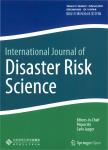Disaster Journalism in Print Media:Analysis of the Top 10 Hydrogeomorphological Disaster Events in Portugal,1865–2015
Disaster Journalism in Print Media: Analysis of the Top 10 Hydrogeomorphological Disaster Events in Portugal, 1865–2015作者机构:Postgraduate Program in Public Health(PPGSC)Federal University of Espírito SantoVitoriaEspírito Santo 29047-105Brazil Centre for Geographical StudiesInstitute of Geography and Spatial PlanningUniversidade de Lisboa1600-276 LisbonPortugal Associate Laboratory TERRA1349-017 LisbonPortugal
出 版 物:《International Journal of Disaster Risk Science》 (国际灾害风险科学学报(英文版))
年 卷 期:2022年第13卷第4期
页 面:521-535页
核心收录:
学科分类:081504[工学-水利水电工程] 08[工学] 09[农学] 0903[农学-农业资源与环境] 0815[工学-水利工程]
基 金:financed in part by the Coordenacao de Aperfeicoamento de Pessoal de Nível Superior—Brasil(CAPES) the Foundation for Supporting Research and Innovation in Espírito Santo(FAPES—Fundacao de AmparoàPesquisa e Inovacao do Espírito Santo),Profix/FAPES/CAPES
主 题:Disaster journalism Hydrogeomorphological events News protocol Portugal Print media
摘 要:Disaster communication guidelines emphasize that journalists should be aware of past major disasters and draw lessons from the coverage of those *** press is an important source for the evolution of historical disaster and risk research paradigms over *** study explored the top 10 damaging hydrogeomorphological events in Portugal selected from the disaster database,which includes events that caused human damages(fatalities,injured,missing,evacuated,and displaced)reported over a period of 151years(1865–2015)by the Portuguese newspaper Diário de Notícias(DN).News analysis was guided by the news *** analysis of the news published in DN enabled us to identify textual marks that present interconnections in the journalistic coverage and produce discursive standards for these *** textual marks were associated with the hazard and risk *** discursive standards of DN did not clearly reflect the ruptures in the hazard *** a rule,the journalistic reports contributed to the naturalization of disasters and the gap in public understanding of risks,by presenting an approach focused on relief actions—ignoring social issues,vulnerability,and population resilience—reducing the discourse of preparedness for future disasters.



